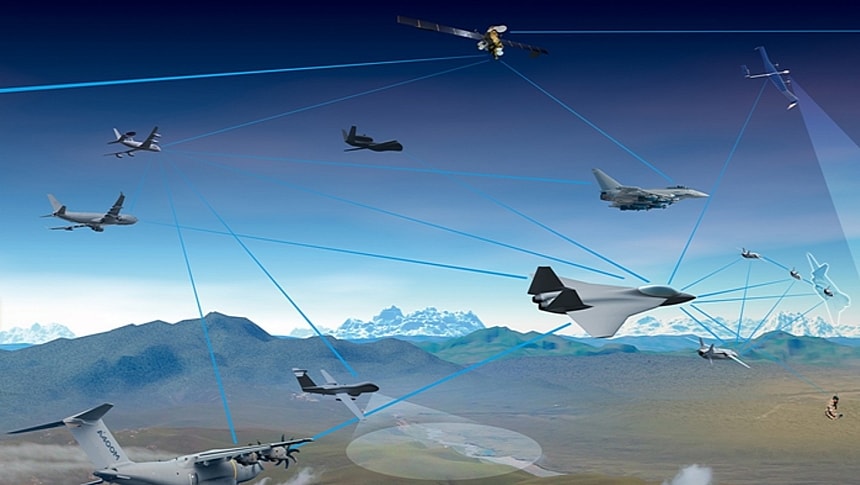Combat drones are coming, and the push now is to make them so smart that they can accompany crewed aircraft in the battlespace, taking on the most difficult and dangerous of challenges. And with them will come a piece of technology that may forever change our world: artificial intelligence (AI) pilots.
The military and defense contractors call accompanying military aircraft Wingman. Several projects are currently underway to create drones that can fly on their own in support of human missions but also allow themselves to be controlled remotely by nearby pilots.
Boeing, for instance, is working on such a technology, and it calls it Ghost Bat. And so do the Europeans from Airbus, which took advantage of the International Aerospace Exhibition (ILA) that took place last week in Berlin, Germany, to present their own unnamed Wingman drone concept.
The design, which we already discussed in a previous story, is first and foremost meant to be used by the German Air Force, at first in support of the current fleet of military aircraft, and later in aid of the sixth-generation fighter jet Europe is currently working on, the Future Combat Air System (FCAS).
The prototype Airbus showed in Berlin was not accompanied by any important details, but we do know some general things about it. First up, the fighter-type aircraft will be capable of flying by itself either in standalone missions or in support of piloted jets, and will be loaded with weapons, sensors, and cameras.
Human pilots flying in nearby aircraft will be able to command it to perform missions such as target reconnaissance, destruction, electronic jamming, or to become a decoy for air defense systems. This would allow the drone to get into the hottest zones of the battlefield while human pilots remain some distance away.
Although technically a human will always be in the loop when it comes to the Wingman's operation, the drones would have to make some of the decisions on how to proceed on their own. And this is where artificial intelligence systems come in.
For its Wingman program, Airbus partnered with British defense AI company Helsing. The brain of the Wingman drone will be developed in such a way that it can make some (undisclosed) decisions, but mostly to better process the data it gets from sensors.
The joint project is in its very early stages, meaning there's not much to talk about at the moment in terms of AI capabilities.
Airbus did not say when its unnamed Wingman drone will be ready for operations, but the partnership with Helsing is a clear sign we will get to see it flying soon enough. What's more, the European aerospace giant already confirmed that some of the tech developed for the Wingman might make it into other future aircraft as well.
Boeing, for instance, is working on such a technology, and it calls it Ghost Bat. And so do the Europeans from Airbus, which took advantage of the International Aerospace Exhibition (ILA) that took place last week in Berlin, Germany, to present their own unnamed Wingman drone concept.
The design, which we already discussed in a previous story, is first and foremost meant to be used by the German Air Force, at first in support of the current fleet of military aircraft, and later in aid of the sixth-generation fighter jet Europe is currently working on, the Future Combat Air System (FCAS).
The prototype Airbus showed in Berlin was not accompanied by any important details, but we do know some general things about it. First up, the fighter-type aircraft will be capable of flying by itself either in standalone missions or in support of piloted jets, and will be loaded with weapons, sensors, and cameras.
Human pilots flying in nearby aircraft will be able to command it to perform missions such as target reconnaissance, destruction, electronic jamming, or to become a decoy for air defense systems. This would allow the drone to get into the hottest zones of the battlefield while human pilots remain some distance away.
Although technically a human will always be in the loop when it comes to the Wingman's operation, the drones would have to make some of the decisions on how to proceed on their own. And this is where artificial intelligence systems come in.
For its Wingman program, Airbus partnered with British defense AI company Helsing. The brain of the Wingman drone will be developed in such a way that it can make some (undisclosed) decisions, but mostly to better process the data it gets from sensors.
The joint project is in its very early stages, meaning there's not much to talk about at the moment in terms of AI capabilities.
Airbus did not say when its unnamed Wingman drone will be ready for operations, but the partnership with Helsing is a clear sign we will get to see it flying soon enough. What's more, the European aerospace giant already confirmed that some of the tech developed for the Wingman might make it into other future aircraft as well.












